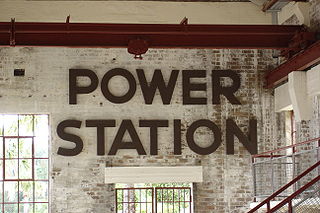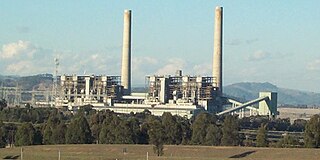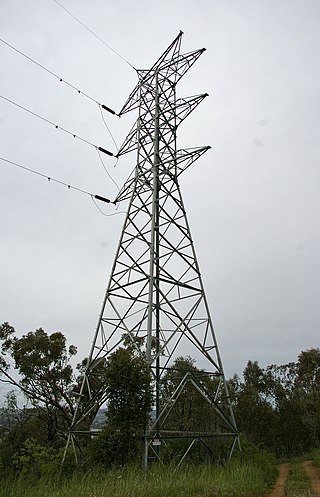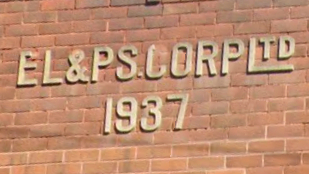Related Research Articles
The Central Electricity Generating Board (CEGB) was responsible for electricity generation, transmission and bulk sales in England and Wales from 1958 until privatisation of the electricity industry in the 1990s.

Origin Energy Ltd is an ASX listed public company with headquarters in Sydney. It is a major integrated electricity generator, and electricity and natural gas retailer. It operates Eraring Power Station, Australia’s largest coal-fired power station, in New South Wales, which it plans to close in 2025. As of 2024, it plans to "minimise" its ownership of wind and solar power, to boost investor returns. It owns 20% of Octopus Energy, a UK renewable energy retailer.

The Balmain Power Station was located at Iron Cove, 4 km (2 mi) from Sydney in New South Wales, Australia. The station no longer exists and residential properties now occupy the site. This plant is often confused with the White Bay Power Station, the remains of which are still standing in Rozelle.

Eraring Power Station is a coal-fired power station consisting of four 720 MW Toshiba steam-driven turbo-alternators for a combined capacity of 2,880 MW. The station is located near the township of Dora Creek, on the western shore of Lake Macquarie, New South Wales, Australia and is owned and operated by Origin Energy. It is Australia's largest power station. The plant has two smokestacks rising 200 m (656 ft) in height. It was scheduled for closure by mid-2025, after a failed attempt to sell the loss making power station back to the state government. The New South Wales Government in May 2024 extended the operational life of Eraring to August 2027.

Vales Point Power Station is one of two operating coal fired power stations on the shores of Lake Macquarie, New South Wales. Vales Point is located on the southern shore of the lake, near the township of Mannering Park. It has two steam turbines, with a total generating capacity of 1,320 MW (1,770,000 hp) of electricity.

Liddell Power Station is a decommissioned coal-fired thermal power station that had four 500 megawatts (670,000 hp) EE steam-driven turbine alternators, providing a combined electrical capacity of 2,000 megawatts (2,700,000 hp).
Cochrane Dam is a minor earthfill embankment dam with concrete spillway across Georges Creek, located in the South Coast region of New South Wales, Australia. The main purpose of the dam is to supply water for hydro-power at the downstream Brown Mountain Power Station and for irrigation purposes. The impounded reservoir is called Cochrane Lake.

The Blayney wind farm is a wind power station at Lake Carcoar, south of Blayney, New South Wales, Australia. It was acquired by Trustpower in 2014, and is now owned by Tilt Renewables. Blayney has fifteen wind turbines, with a total nameplate capacity of 9.9 MW of electricity.

Integral Energy was the second largest state-owned energy corporation in New South Wales, incorporated under the Energy Services Corporations Act 1995 from a merger between Prospect Electricity and Illawarra Electricity. Integral Energy was involved in electricity retail in addition to owning an electricity distribution network and previously held licences to retail electricity in the contestable markets covered by the NEM.
Eraring Energy was an electricity generation company in Australia that was owned by the Government of New South Wales, and had a portfolio of generating sites using thermal coal, wind, and hydroelectric power. It was sold to Origin Energy in 2013.

Wangi Power Station is a heritage-listed former coal-fired power station at Wangi Wangi, City of Lake Macquarie, New South Wales on Lake Macquarie. The power station operated between 1956 and 1986 and supplied electricity to New South Wales. It was once the largest in the state. The 12,000-square-metre (130,000 sq ft) building was listed on the New South Wales State Heritage Register on 2 April 1999.

The Electricity Commission of New South Wales, sometimes called Elcom, was a statutory authority responsible for electricity generation and its bulk transmission throughout New South Wales, Australia. The commission was established on 22 May 1950 by the Electricity Commission Act 1950 to take control of power generation in the State. The commission acquired the power stations and main transmission lines of the four major supply authorities: Southern Electricity Supply, Sydney County Council, the Department of Railways and the Electric Light and Power Supply Corporation Ltd, also known as the Balmain Electric Light Company, the owner and operator of Balmain Power Station. The commission was responsible for the centralised co-ordination of electricity generation and transmission in the State, and some local councils continued to be distributors of electricity only.
Transgrid is the manager and operator of the high voltage electricity transmission network in New South Wales and the Australian Capital Territory, Australia, and is part of the National Electricity Market (NEM). The company's offices are located in Sydney, Newcastle, Orange, Tamworth, Wagga, and Yass.

Tamil Nadu Electricity Board is a power generation and distribution company owned by Government of Tamil Nadu, India. It was created as a regulated monopoly under section 131 of the Electricity Act (2003) as a successor of the erstwhile Tamil Nadu Electricity Board. It is the largest State Electricity Board (SEB) in the country in terms of number of consumers.
The Energy Commission, abbreviated ST, is a regulatory body for the energy industry in Peninsular Malaysia and Sabah. The commission was established under the Energy Commission Act 2001. Its key role to ensure that the energy industry is developed in an efficient manner so that Malaysia is ready to meet the new challenges of globalisation and liberalisation, particularly in the energy supply industry.
Myuna Colliery is a coal mine at Wangi Wangi, New South Wales, Australia. The colliery was developed to provide coal for the Eraring Power Station, 5 kilometres to the west. The mine started in August 1979, with coal production commencing in 1982. The Wallarah, Great Northern and Fassifern coal seams have been mined using bord and pillar mining methods. Coal is transported to the Eraring Power Station by an overland conveyor system.
Macquarie Generation is an electricity generation company in New South Wales, Australia, owned by AGL Energy, and has a portfolio of generating sites using predominantly thermal coal power. The company now trades as AGL Macquarie and generates electricity for sale under contract.

Electric Light and Power Supply Corporation Limited was a privately owned listed company that generated and distributed electrical power to suburbs within the Inner West of Sydney, New South Wales Australia, from 1909 to 1956. It owned and operated the Balmain Power Station. It was nationalised in 1956, by the New South Wales Government, and its assets and operations became a part of the Electricity Commission of New South Wales, on 1 January 1957.
Southern Electricity Supply was a corporation sole that controlled and administered the electricity supply assets of the New South Wales Department of Public Works, from 1942 to 1950. It operated a number of coal-fired and hydro-electric power stations in New South Wales, and was a bulk electricity supplier to part of New South Wales, mainly in the south and south central-west of the state. In November 1950, its assets and operations were merged into the Electricity Commission of New South Wales.
References
- ↑ "Electricity Commission of New South Wales". NSW Department of Records. Archived from the original on 30 August 2007. Retrieved 28 September 2007.
- ↑ "Harold Graydon Conde (1898–1959)". Conde, Harold Graydon. National Centre of Biography, Australian National University. Retrieved 28 September 2007.
{{cite book}}:|work=ignored (help) - ↑ "Electricity Deregulation Outside the New South Wales and Victorian Markets" (PDF). Roarty, M. Archived from the original (PDF) on 13 July 2007. Retrieved 28 September 2007.
- ↑ "Connell Wagner acquires Pacific Power International". www.infolink.com.au. Retrieved 2008-04-02.[ permanent dead link ]
- ↑ "Pacific Power (Dissolution) Bill". www.parliament.nsw.gov.au. Archived from the original on 2007-10-19. Retrieved 2008-04-02.